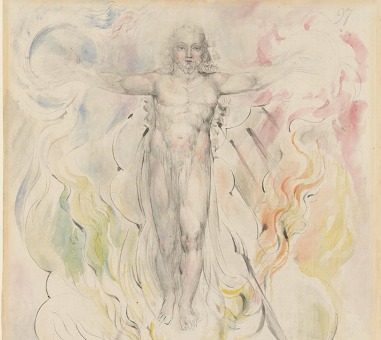William Blake (1757-1827) was a uniquely multifaceted figure distinguished most of all by the originality of his imagination. He was complex, and would agree heartily with the 1841 statement of Ralph Waldo Emerson (1803-1882): “A foolish consistency is the hobgoblin of little minds, adored by little statesmen and philosophers and divines. With consistency a great soul has simply nothing to do.” From the age of four he spoke of powerful, sometimes terrifying, visions. His wife recalled that God “put his head to the window and set [Blake] ascreaming.” By ten he knew that he wanted to be a painter and he began writing poetry at twelve. A five-year apprenticeship with the engraver James Basire taught him the central importance of line. Basire sent him often to draw in evocative settings such as the tombs of Westminster Abbey, which deepened Blake’s appreciation of England’s medieval past, in contrast to the then overwhelming cultural preference for Palladian and other classical precedents. He also developed a profound appreciation for the Bible, primarily as a work of poetry, albeit containing profound truth. He did not take kindly to authority of any sort, including Scriptural authority. So his written, printed and painted works comprise a broad spectrum of penetrating insights into the Biblical narrative, and clouds of confusion. The death of his younger brother Robert in 1787 was a massive blow to Blake. Nevertheless, the artist found inspiration in the midst of this loss, claiming that in a dream Robert unveiled to him the secrets allowing him to draw directly on copper plates, rather than rely on engravers replicating drawn designs. This technique, relief-etched printing of raised lines on incised plates, was both an artistic and commercial breakthrough, enabling Blake’s integrated control of the entire process. His Songs of Innocence (1789, with 27 plates) and Songs of Innocence and Experience (1794, with 54 plates) put this new “illuminated” technique into practice. Despite his prodigious creative gifts, his recognized productivity and his wide-ranging friends and patrons, Blake never found a way to make much of a living from his art or his poetry. As he worked with ardor on the Dante watercolors and engravings in his cramped, dark London quarters, Blake succumbed to a noxious mix of Irritable Bowel Disease and two other related illnesses, likely caused or exacerbated by his exposure to the fumes which nitric acid produced as he applied it to his copper plates. Blake was reported to spend one of his last shillings on a new pencil so that he could keep working on his Dante drawings. The day of his death, he laid down his pencil only to sketch his wife, then sing hymns in peaceful readiness to meet the Lord whose glorious face he had spent so many hours imagining and seeking to express in word and image. For more, see http://www.blakearchive.org
%20(1).png)
%20(1).png)







